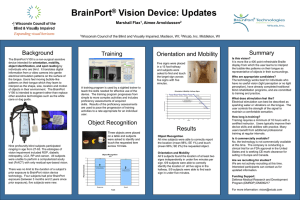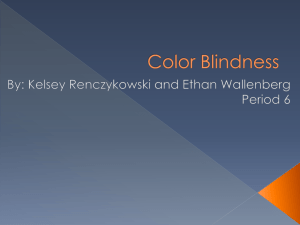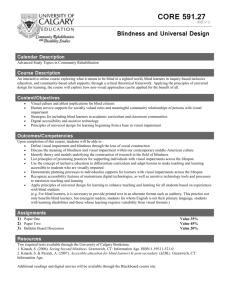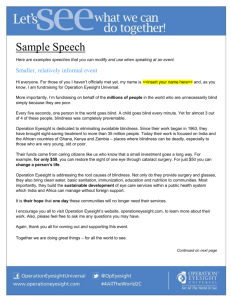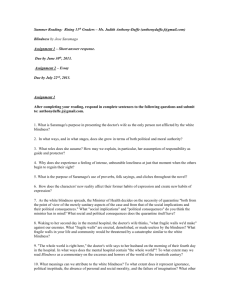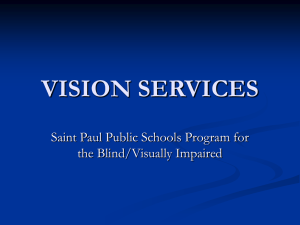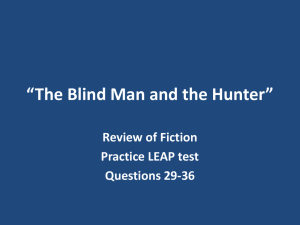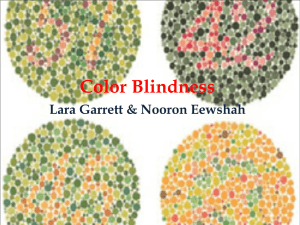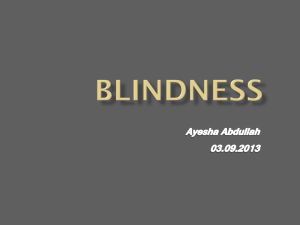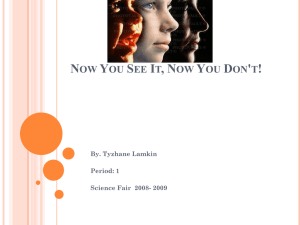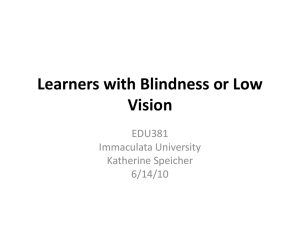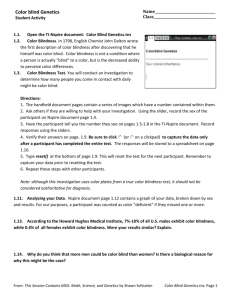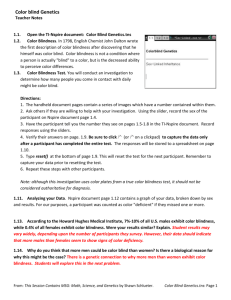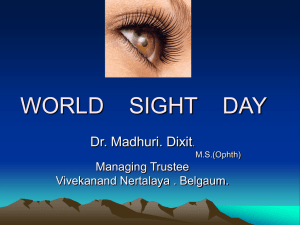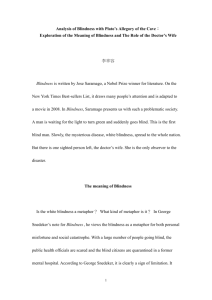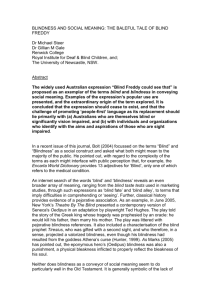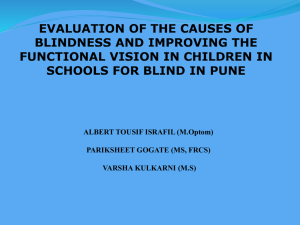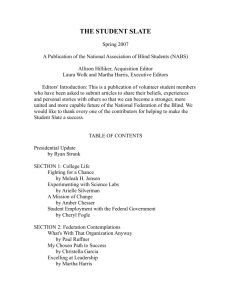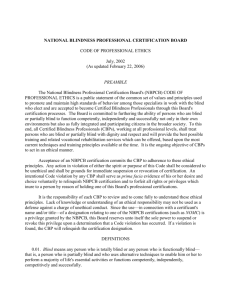A survey of demographic traits and assistive device use in a blind
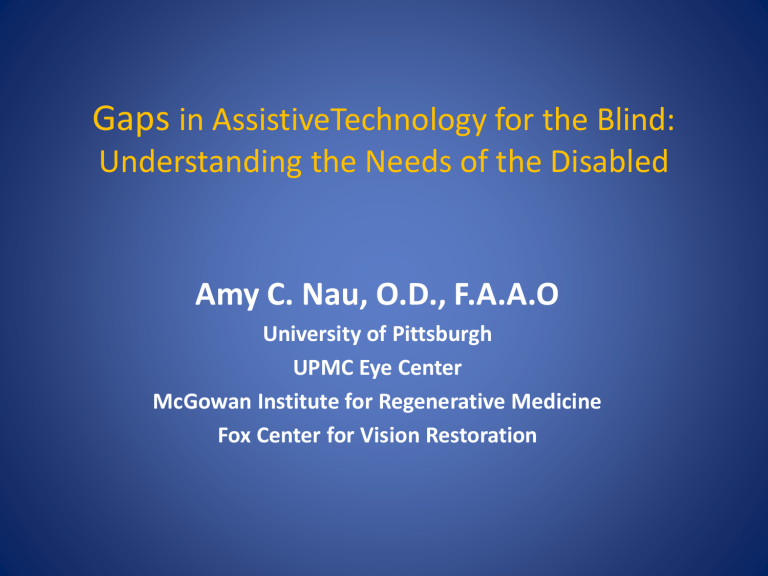
Gaps in AssistiveTechnology for the Blind:
Understanding the Needs of the Disabled
Amy C. Nau, O.D., F.A.A.O
University of Pittsburgh
UPMC Eye Center
McGowan Institute for Regenerative Medicine
Fox Center for Vision Restoration
Technology provides endless possibilities for improving the lives of the visually impaired
BUT…
Hitting the mark and actually serving the needs of the blind requires -----that you understand the stakeholders.
Who are the Stakeholders?
• The blind person
• Their family or caregivers
• Clinicians
• Occupational therapists
• CMS/government
• Insurance companies
• Manufacturers/Vendors
• Collaborators
Background- Sensory Substitution
Uses a mini camera that sends an image to an
400 array electro-tactile tongue display
KDKA video
Studies 2009-present
• Veteran’s Study (n=10)
– First home use
– Device Feedback
– Safety Outcome
• Outcomes Study (n=30)
– Design and validate outcomes test
– PET/MRI
• FDA Safety Study
– 70 subjects @ 8 sites, 18 subjects @ UPMC
– Device safety
– Behavioral outcomes
• Telerehabilitation Study
(n=10)
– Remote/virtual low vision rehabiltation
• Enhancing Device Study
(n=20)
– Hardware upgrades
– Software upgrades
– CMU/RI
• Facial/object recognition
• Mobility enhancement
• fMRI
• SS in Aging
– fMRI in the acquired blind
(n=20)
Outcomes Assessments
• BaLM
• BaGA
• FrACT
• Visual field (TS)
• Object recognition
• Word recognition
• Depression Screen
• QoL (VFQ-25 and AI)
• Obstacle Course
• EMR
• Flash VEP
• MRI (DTI/tractography)
• PET
Purpose- understand the gaps
In conjunction with the CMU QoLT, we were seeking information about how AD for the totally blind could be improved and further developed.
• Investigate usage patterns of assistive devices
(AD)
• Investigate satisfaction with current AD
• Provide information regarding perceived deficiencies in AD
• Provide insight about desired AD attributes and functions
• Relate this information to demographic status
Methods
• Single center, cross sectional telephone survey
• 114 mixed, open ended questions
Demographics
Nature of blindness
Education
Health status
Exercise status
Living situation
Activities of Daily Living
Ability to perform activities as relate to blindness
Self –reported level of independence
Work/Recreation
Adaptation to Blindness
Use of other senses
Methods to compensate
+/- aspects of AD
Gaps in Current Technology
Ability to adapt to novel AD
Wish lists for future AD
Subjects
Recruited from SS Lab research registry
n=76 blind male and female adult subjects
(LP or worse bilaterally from any cause)
Average age
52.3years (range 20-
80 years) perinatal
20%
<1y
2%
1-5y
20%
Duration of
Blindness
>10y
35%
6-9 y
23%
Results
Educational Attainment
• 95% at least some high school
• 25% high school diploma
• 15% associates degree
• 12.5% bachelors degree
• 5% some grad school
• 7.5% master’s degree
• 10% doctorate degree
• 60% Braille literate ***
Results- Lifestyle
• 37% live alone
– 13% of these receive daily assistance from caregiver
• 87.% exercise regularly
– 57.1% exercise outside the home
• In 2001, 45.4% of adults in the general population of the
United States engaged in activities consistent with physical activity recommendations
Self Reported Health Status %
38,5
33,3
25,6 excellent very good good
2,6 fair
0 poor
How often do they leave home?
Leaving home (number of times per day)
20% leave < once
40% leave once
40% more than once
Degree to which our respondents felt they were able to function independently for the listed activities
Activity totally independent somewhat independent dependent
Eat
Bathe
Get dressed
Trim nails
Brush teeth
Distinguish medications
Walk on sidewalk
90.00%
95.00%
92.50%
70.00%
97.50%
57.50%
60.00%
Cross a street
Navigate stairs
Find a building
Find a room within a building
40.00%
92.50%
33.30%
32.50%
Read directional/informational signs 0.00%
Identify currency
Identify products
Use a computer
Reach for an object
Locate a person
37.50%
32.50%
58.30%
77.50%
62.50%
10.00%
2.50%
7.50%
17.50%
2.50%
32.50%
30.00%
27.50%
5.00%
43.60%
45.00%
2.60%
40.00%
50.00%
22.20%
17.50%
32.50%
0.00%
2.50%
0.00%
12.50%
0.00%
10.00%
10.00%
32.50%
2.50%
23.10%
22.50%
97.40%
22.50%
17.50%
19.40%
5.00%
5.00%
70.00%
60.00%
50.00%
40.00%
30.00%
20.00%
10.00%
0.00%
Results- Activities
Reasons for Leaving Home never once a year once a month once a week daily
RESULTS-
TRANSPORTATION
100.00%
80.00%
60.00%
40.00%
20.00%
0.00%
Gaps in Mobility
• 87.2% rely on a cane for ambulation
• 39% of those surveyed maintained that they walked as their main mode of transport.
• 9.9% of our respondents said their mobility device (i.e. cane) was their most useful technology
• 60% of our subjects cannot cross a street without assistance
• 97.4% are totally dependent on others to interpret directional or other signs
• 66.7% rely at least partially on others to find a building
• 17.4% reported that mobility was an issue inside the home
• 60.0% reported mobility problems outside the home.
Insert video of blind person using the BrainPort
(Lighthouse then Jose Neto)
Results- Employment
• 50% were employed
– 31 % office
– 30% management
– 15% professionals
– 10% educators
– 20% laborers
Results - Employment
33% reported no problems at work because of blindness
EMPLOYEMENT PROBLEMS RELATED TO BLINDNESS
40.00%
35.00%
30.00%
25.00%
20.00%
15.00%
10.00%
5.00%
0.00%
Difficult tasks
Impossible tasks
Results Device Usage/Adaptation
Would you sacrifice an intact sense?
50% yes
21% no
29% not sure
How do you identify objects?
Touch 97.5%
Smell 20%
Sound 15%
How do you identify people?
vocal cues 97.5%
Smell 20%
How do you identify places?
Sound 56.2%
Touch 28%
Smell 28%
Attitudes towards Technology
• 60.0% of respondents use text to speech
• 12.5% use a cell phone or smartphone
• 56.4% denied that technology makes them nervous or apprehensive
• 23.1% reported being uncomfortable with technology.
Is it better to have one device or many devices?
• General Use 42.4%more versatile, less expensive fewer devices
• Special purpose 36.4%best performance, less superfluous functionality
• No preference 21.2%
• 53.8% claimed that the number of tasks a device could be used for was “very important”.
Technology
Advantages Desired
Improvements
Disadvantages
Literacy
Communication
Recreation
Other
Object ID interface
Portable
Smaller
Consistency
Reliability
Interface
Other
Interface
Not tailored to blind
Inaccuracy
Not portable
Technical Issues
Battery life
Other
Method for determining type, functionality, advantages, disadvantages and possible improvements for devices that respondents were currently using.
Advantages of Current Assistive Devices
80,00%
70,00%
60,00%
50,00%
40,00%
30,00%
10,00%
0,00%
Currently Used
Ever Used
Disadvantages
• Not user friendly
• Too hard to learn
• Unreliable
• Cost
• Cosmetically unacceptable
Proposed Improvements other blind friendly interface more consistent/ reliable smaller
0.00% 10.00% 20.00% 30.00% 40.00% 50.00% 60.00%
Ever Used Currently Used
Describes more subtle features of a device that might lead to commercial success or failure.
Not at all important
Somewhat unimportant
Neither unimportant nor important
Somewhat important
Very important
How well technology meets needs
Versatility
Ease of use
Cost
Attractiveness
0.00% 0.00%
0.00% 3.10%
6.20% 3.10%
15.60% 6.20%
25.00% 18.80%
3.10%
21.90%
21.90%
34.40%
40.60%
9.40%
18.80%
15.60%
9.40%
9.40%
87.50%
56.20%
53.10%
34.40%
6.20%
Noticeable 25.00% 18.80% 34.40% 12.50% 9.40%
How hard it is to learn to use
Frequency of personal maintenance
Frequency of
Professional maintenance
25.00%
28.10%
21.90%
18.80%
6.20%
6.20%
25.00%
12.50%
25.00%
9.40%
12.50%
12.50%
21.90%
40.60%
34.40%
specific functions of devices according to their perceived usefulness
Function of Device
How useful is it?
Current
Device
Any
Device
Used text identification
80.0% 45.1% non-text identification
15.0% 8.5%
35.0% 19.7% communication mobility
17.5% 9.9%
12.5% 7.0% recreation other
17.5% 9.9%
Training- began in earnest in 2011
Obstacle Detection in Dim Light
0,6
0,5
0,4
0,3
0,2
0,1
0
0,9
0,8
0,7
1 1 1 1 2 2 2 2 3 3 3 3
Course Number
20 hours –NOT ENOUGH
Light Obstacles Identified
Dark Obstacles Identified
Obstacle Detection in Bright Light
0,9
0,8
0,7
0,6
0,5
0,4
0,3
0,2
0,1
0
Light Obstacles Identified
Dark Obstacles Identified
1 1 1 1 2 2 2 2 3 3 3 3
Course Number
3 Month f/u--Lessons Learned
• Once they get home…..
– Core skills acquired are quickly forgotten
– Intimidation
– Boredom
– Transportation / access is the barrier to returning for additional rehab training
=
Loss of interest
Device abandonment
Barriers to Follow up
• Capacity
– -not enough LVOT or providers to provide ongoing rehab sessions
• Transportation and reliance on others to get to appointments
• Perceived failure of devices due to confusion
• Geographic barriers
• It is often not known by the clinician whether the patient accepts the recommendations and/or correctly implements them in their home environment.
Telerehabilitation – A solution??
TR refers to the delivery of rehabilitation services via information and communication technologies . Rehabilitation services include assessment, monitoring, prevention, intervention, supervision, education, consultation, and counseling.
Cost Considerations
Summary
• Current assistive devices do a fairly good job at facilitating literacy
• enhancing mobility or interpretation of the environment (i.e. signs) are a huge gap.
• The blind seek devices that are tailored to their needs, reliable, easy to use and are not prohibitively expensive
Summary
• Engage with the blind community
• Each stakeholder plays a vital role in the success of your project
• Get continuous feedback from everyone all the time
• You want to hear that you are wrong!!
Joel Schuman
Kevin Chan
Chrissie Pintar
Christopher Fisher
Jacki Fisher
Valeria fu
Dongsheng Yang
Rich Hertle
Aimee Arnoldussen
Rich Hogle
Charles Laymon
Vincent Lee
Matthew Murphy
Yaser Sheikh
Yair Movshovitz-Attias
Amy Rebovich
Ken Wojznik
Mark Kislan
Deborah Fenton
Pam Howe
Melissa Lowalkowski
Judith Shanahan
Wendy Chen
Tobin Vijayin
Jenna Sembrat
Julie Steinbrink
Alex Keifer
Cody Wolfe
Kathleen Janesco
David Moffa
Myles Nightingale
Courtney Elvin
Daniel Chen
Acknowledgments
National Institutes of Health CORE Grant P30 EY008098
Eye and Ear Foundation of Pittsburgh, PA
Unrestricted Grant from Research to Prevent Blindness, New York, NY
Defense Medical Research and Development Program (DM090217), Department of Defense,
USA
Fine Foundation
DCED State of PA
Louis J. Fox Center for Vision Restoration- OTERO
Lion’s Club
Aging Institute University of PIttsburgh


